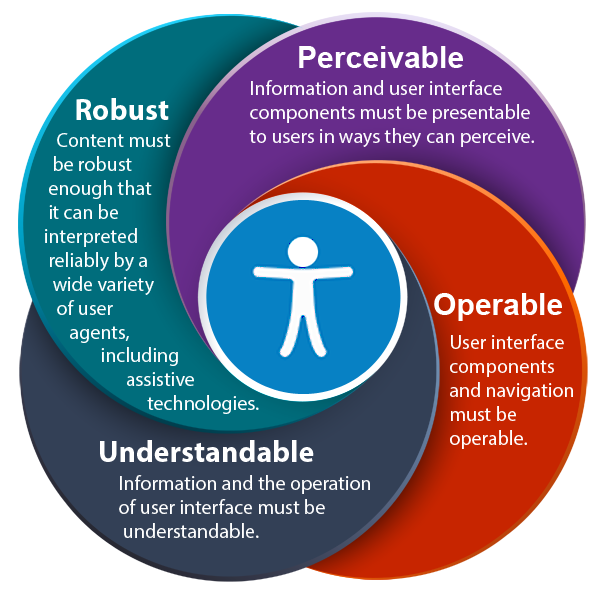Web Content Accessibility Guidelines 2.0: Difficulties of Conformance

W3C logo

The WCAG principles—Perceivable, Operable, Understandable, and Robust—are often referred to by the acronym "POUR."
Credit: Regents of the University of Minnesota, 2016, http://www.d.umn.edu/itss/news/2016/05/wcag_principles.html.
The Website Content Accessibility Guidelines (WCAG) 2.0 “is a stable, referenceable technical standard. It has 12 guidelines that are organized under 4 principles: perceivable (Information and user interface components must be presentable to users in ways they can perceive), operable (User interface components and navigation must be operable), understandable (Information and the operation of user interface must be understandable), and robust (Content must be robust enough that it can be interpreted reliably by a wide variety of user agents, including assistive technologies). For each guideline, there are testable success criteria, which are at three levels: A, AA, and AAA” (which I will discuss further shortly). Some initial responses to WCAG 2.0 when it first rolled out revealed the difficult and counterproductive nature of the guidelines. For example, Joe Clark (2006), a web accessibility expert and writer, complained that WCAG 2.0 is unreasonable and that “the fundamentals of WCAG 2 are nearly impossible for a working standards-compliant developer to understand [...] you as a working standards-compliant developer are going to find it next to impossible to implement WCAG 2.” Conway (2016), writing 10 years later, expressed that “the guidelines themselves are not always specific.” Fortunately, the “Techniques for WCAG 2.0” document is updated every two years to offer current practices and some help with meeting the guidelines, in addition to the “How to Meet WCAG 2.0” and “Understanding WCAG 2.0” documents. Because the guidelines can be so vague, there is a lot of room for individual interpretation, so it is highly recommended for web content developers to refer to the “Techniques” document for a starting place. As Bradley 2015 mentions, “[y]ou can find the techniques in the same documents as the success criteria. They’re included as a collection of links to yet more pages with yet more details” (Bradley 2015). However, it is important to know that none of these techniques are required. As long as the success criteria are met, it does not so much matter what techniques and methods were used to meet them (Bradley 2015).

header for "Techniques for WCAG 2.0" webpage
Besides understanding the guidelines themselves and how to achieve them, developers run into difficulty with meeting the WCAG criteria due to limited resources. Both meeting criteria, especially those of Conformance Level AAA, and testing accessibility according to WCAG 2.0 can be very difficult and intensive, in time, cost, and labor. For example, Guideline 1.2.6 requires that “[s]ign language interpretation is provided for all prerecorded audio content in synchronized media.” This is a Level AAA criteria and may not be realistically achieved by web content developers without large budgets or access to resources, such as a sign language interpreter. Further, as Conway (2016) explains, “[t]esting against WCAG guidelines can be challenging. Websites must be tested using a variety of different operating systems, versions and types of browsers.” If say, a small web developer, does not have access to various operating systems and devices, it will be impossible to to ensure that his/her website is universally WCAG 2.0 compliant.
One way to approach this challenge is to start with a conformance level that is practically achievable. According to Bradley (2015) “The spec notes that some content can’t meet all the criteria for AAA compliance and doesn’t recommend level AAA for all sites. Level AA is really the sweet spot . . . Before you spend too much time wading through all the details of a particular success criteria, you’ll want to decide which level of conformance you’re aiming for and then focus on the criteria and techniques that are the same level or lower.” The Conformance levels are cumulative, which means that conformance at a higher level indicates conformance at lower levels, i.e. conformance to Level AA necessarily implies conformance to Level A (General Services Administration n.d.). As outlined by the U. S. General Services Administration, the “WCAG 2.0 Success Criteria are categorized according to three levels providing successively greater degrees of accessibility:
- Level A (minimum) – the most basic web accessibility features
- Level AA (mid-range) – deals with the biggest and most common barriers for disabled users
- Level AAA (highest) – the highest level of web accessibility."

WCAG 2.0 Standards at a Glance
Conformance Level AA does, indeed, seem to be the “sweet spot.” It has been “proposed as the new standard for the anticipated refresh of the Access Board Standard for Section 508. The WCAG document does not recommend that Level AAA conformance be required as a general policy because it is not possible to satisfy all Level AAA success criteria for some content.” (General Services Administration n.d.)

WCAG 2.0 Level AA Compliance is the legal standard for website accessibility.
References
Avila, Jonathan. “ACCESSIBILITY CONFORMANCE LEVELS: REDUCING RISK.” Level Access, August 14m 2017, https://www.levelaccess.com/accessibility-conformance-levels-reducing-risk/.
Bradley, Steven. “WCAG 2.0 — Criteria And Techniques For Successful Accessibility Conformance.” Vanseo Design. June 29, 2015, http://vanseodesign.com/web-design/wcag-success-criteria-techniques/.
Clark, Joe. “To Hell with WCAG 2.” A List Apart, May 23 2006, https://alistapart.com/article/tohellwithwcag2
Conway, Ash.”The challenges of WCAG 2.0 Compliance.” Bugwolf.com, November 8, 2016. https://bugwolf.com/blog/the-challenges-of-wcag-2-0-compliance.
General Services Administration. United States. “WCAG 2.0 Conformance.” section508.gov, n.d., https://www.section508.gov/content/build/website-accessibility-improvement/WCAG-conformance.